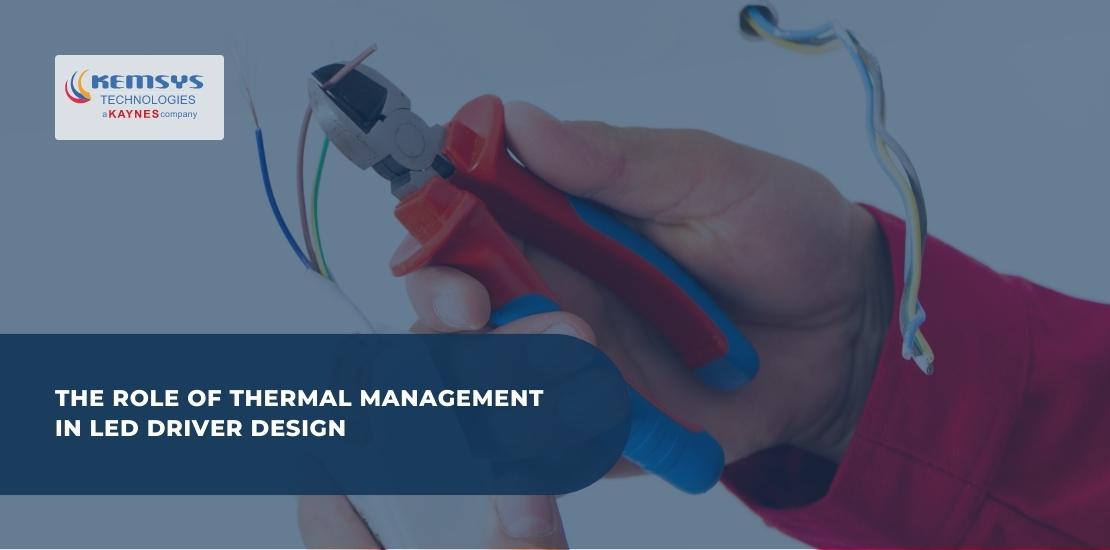- April 21, 2023
- Posted by: Swapnil Ghaisas
- Categories: Device Engineering, Quality Engineering

Light Emitting Diodes (LEDs) have revolutionized the lighting industry with their energy efficiency and durability.
However, their performance is highly dependent on temperature, and improper thermal management can significantly reduce their lifespan and performance.
This is where the role of thermal management in LED driver design comes into play.
Effective thermal management is crucial to ensure optimal LED performance and reliability, making it a critical aspect of LED driver design.
Check out – the design considerations for High Efficiency LED Drivers in Consumer Lighting.
In this article, we will explore the importance, benefits, and factors affecting thermal management in LED Driver design. Also, various other aspects of effective thermal management would be discussed. Join us as we delve deeper into the crucial role of thermal management in LED driver design.
- What is Thermal Management in LED Driver Design
- Benefits of Effective Thermal Management in LED Driver Design
- Factors Affecting Thermal Management in LED Driver Design
- Techniques for Effective Thermal Management in LED Driver Design
- Methods of Heat Dissipation in LED Driver Design
- Future Developments in Thermal Management for LED Systems
- Final Thoughts
What is Thermal Management in LED Driver Design
Thermal management in LED driver design refers to the techniques and strategies used to manage the heat generated by the LED driver and the LED itself.
As LED drivers operate, they generate heat, which can cause the driver and the LED to overheat, potentially leading to decreased performance, reduced lifespan, or even failure.
Effective thermal management in LED driver design involves designing the driver and the system in a way that allows heat to be dissipated efficiently and effectively, preventing overheating and ensuring optimal performance over the long term.
This can involve a range of techniques, including the use of heat sinks, thermal interface materials, careful PCB layout, thermal vias, active cooling, and high-efficiency driver design.
Effective thermal management is particularly important for LED drivers because LEDs are sensitive to high temperatures.
High temperatures can cause the LED to degrade more quickly, resulting in reduced light output, color shift, and a shorter lifespan.
By managing heat effectively, LED drivers can maintain optimal operating temperatures, ensuring consistent performance and extending the lifespan of the LED.
Overall, Thermal management is a critical aspect of LED driver design that ensures the reliable and optimal performance of the driver and the LED over the long term. Effective thermal management can help prevent overheating, extend the lifespan of the LED, and reduce failure rates, resulting in cost savings and increased customer satisfaction.
Benefits of Effective Thermal Management in LED Driver Design
Effective thermal management is critical for ensuring the long-term reliability and optimal performance of LED drivers.

Here are some of the key benefits of effective thermal management in LED driver design:
- Improved LED lifespan: High temperatures can significantly reduce the lifespan of LEDs. Effective thermal management can help dissipate heat and keep the LED cooler, which can extend its lifespan and improve its overall performance.
- Reduced failure rates: Overheating can also cause other components in the LED driver to fail, resulting in reduced reliability and performance. Effective thermal management can help in reducing failure rates.
- Improved performance: LED drivers that operate at lower temperatures can deliver better performance and maintain their efficiency over time. Thermal management can help ensure that the driver operates within its optimal temperature range, improving overall performance.
- Cost savings: Effective thermal management can help reduce energy consumption and improve efficiency, resulting in cost savings over the long term. It can also help prevent the need for costly repairs or replacements due to component failures caused by overheating.
- Compact design: Efficient thermal management can help reduce the size and weight of the LED driver, which can be particularly important in applications where space is limited or weight is a concern.
- Increased customer satisfaction: LED products that operate reliably and efficiently can help increase customer satisfaction, leading to better customer reviews, increased brand reputation, and higher sales.
Check out – How to Create High-Efficiency LED Drivers that Meet the Demands of Modern Consumer Lighting Applications?
Factors Affecting Thermal Management in LED Driver Design
There are several factors that can affect the thermal management requirements of an LED driver, including:
- Power dissipation: The amount of power dissipated by an LED driver depends on various factors, such as the input voltage, the LED current, and the number of LEDs in the circuit. Higher power dissipation can result in higher temperatures, making effective thermal management critical. Designing LED drivers for a wide input voltage range is critical to ensuring reliable and efficient operation.
- Ambient temperature: The ambient temperature of the environment in which the LED driver operates can affect its thermal performance. For example, if the driver operates in a hot environment, its thermal management requirements will be more stringent than in a cooler environment.
- LED operating temperature: The maximum operating temperature of an LED is typically specified by the manufacturer and can vary depending on the type and construction of the LED. To ensure optimal performance and lifespan, it is important to keep the LED temperature within its specified range.
- Thermal conductivity of materials: The thermal conductivity of the materials used in the LED driver can affect its thermal management performance. For example, materials with higher thermal conductivity, such as copper or aluminum, can dissipate heat more efficiently than materials with lower thermal conductivity, such as plastic.
- Heat sink design: The design of the heat sink used in the LED driver can also impact its thermal management performance. Factors such as the surface area, the number of fins, and the shape of the heat sink can affect the heat dissipation rate and efficiency.
Several factors can impact the thermal management requirements of an LED driver, including power dissipation, ambient temperature, LED operating temperature, thermal conductivity of materials, and heat sink design.
Understanding these factors is crucial for LED drivers that operate reliably and efficiently over the long term.
Read more – How to Choose High-Efficiency Components for LED Drivers?
Techniques for Effective Thermal Management in LED Driver Design
Effective thermal management is essential for ensuring that LED drivers operate reliably and efficiently. Here are some common techniques used in LED driver design to manage heat and prevent overheating:
- Heat sinks: Heat sinks are a common technique used to manage heat in LED drivers. They are typically made of materials with high thermal conductivity, such as aluminum or copper, and are designed to dissipate heat away from the driver and LED. The size, shape, and number of fins on the heat sink can impact its effectiveness.
- Thermal interface materials: Thermal interface materials, such as thermal pads or thermal grease, are used to improve the thermal transfer between the LED and the heat sink. These materials can fill gaps and improve contact between the two surfaces, increasing the efficiency of heat transfer.
- PCB layout: The layout of the PCB can impact the thermal performance of the LED driver. Careful PCB design can improve heat dissipation and prevent hotspots from forming.
- Thermal vias: Thermal vias are small holes drilled into the PCB that allow heat to transfer from one side of the board to the other. This can be particularly useful for LED driver designs where the driver and LED are on opposite sides of the board.
- Active cooling: In some cases, active cooling techniques such as fans or liquid cooling may be required to manage heat in LED drivers. These techniques can be effective but may add complexity and cost to the design.
- Driver efficiency: Finally, it is important to design LED drivers with high efficiency, as this can reduce the amount of heat generated in the first place. This can be achieved through the use of high-efficiency components, careful circuit design, and appropriate driver sizing.
Thermal management in LED driver design requires a combination of techniques, including heat sinks, thermal interface materials, PCB layout, thermal vias, active cooling, and driver efficiency. Careful consideration of these factors can help ensure that LED drivers operate reliably and efficiently over the long term.
Methods of Heat Dissipation in LED Driver Design
There are several methods of heat dissipation that can be used in LED driver design to manage thermal issues:
- Conduction: This method involves transferring heat through a material by direct contact. In LED driver design, this can be achieved by using heat sinks or thermal pads to dissipate heat away from the components.
- Convection: This method involves transferring heat through a fluid, such as air or liquid. In LED driver design, this can be achieved by using fans or other types of air or liquid flow to cool the components.
- Radiation: This method involves the transfer of heat energy through electromagnetic radiation. In LED driver design, radiation can be used to transfer heat from the components to the surrounding environment.
- Phase-change cooling: This method involves using a material that changes phase (e.g., from liquid to gas) to absorb heat and transfer it away from the components.
- Thermoelectric cooling: This method involves using the Peltier effect to transfer heat from one side of a thermoelectric device to the other. This method can be used to cool components directly or to cool a heat sink or other cooling device.
The choice of heat dissipation method will depend on factors such as the size and complexity of the LED driver, the amount of heat generated by the components, and the operating environment. Often, a combination of methods may be used to achieve optimal thermal management in LED driver design.
Future Developments in Thermal Management for LED Systems
As LED lighting technology continues to advance and becomes more prevalent in various applications, the importance of thermal management in LED driver design will only increase.

Here are some potential future developments in thermal management for LED systems:
- Advanced cooling technologies: With the increasing demand for high-powered LED lighting solutions, the use of advanced cooling technologies such as liquid cooling, phase-change cooling, and thermoelectric cooling may become more common.
- Integration of thermal management and control systems: Future LED driver designs may incorporate advanced thermal sensing and control systems that can monitor and adjust temperature levels in real-time for improved thermal management.
- Use of advanced materials: The development of new materials with higher thermal conductivity and improved heat dissipation properties could lead to more efficient thermal management in LED driver design.
- Improved modeling and simulation tools: The use of advanced modeling and simulation tools can aid in the design and optimization of LED driver thermal management systems, allowing for more accurate predictions of system performance and efficiency.
- Use of artificial intelligence (AI) and machine learning: AI and machine learning algorithms can be used to analyze and optimize LED driver thermal management systems, improving efficiency and performance over time.
Final Thoughts
- Thermal management is a critical aspect of LED driver design that can significantly impact the performance, reliability, and lifespan of LED lighting systems.
- Effective thermal management is crucial for ensuring the long-term reliability, optimal performance, and cost-effectiveness of LED drivers. It can also help improve customer satisfaction and brand reputation.
- Understanding the factors like power dissipation, ambient temperature, LED operating temperature, thermal conductivity of materials, and heat sink design is crucial for designing LED drivers that operate reliably and efficiently over the long term.
- Factors such as component selection, PCB layout, and heat dissipation methods should be considered when designing LED drivers with optimal thermal management.
- The future of thermal management in LED driver design looks promising, with a continued focus on developing more efficient, reliable, and cost-effective solutions for LED lighting applications.
- Stay updated with the latest developments to ensure the best performance of your LED lighting systems.

